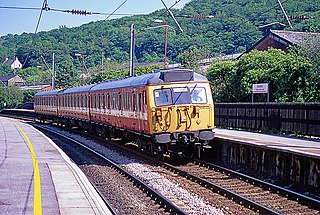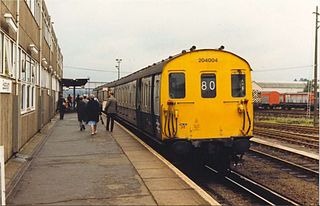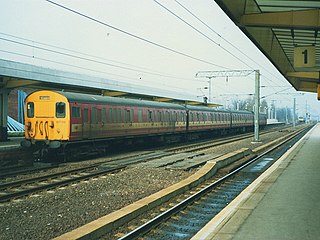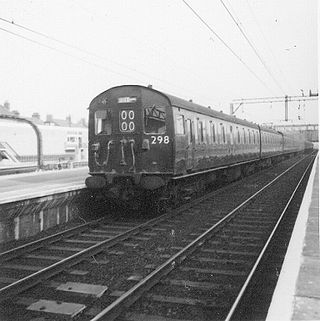
The British RailClass 411 (4CEP) electric multiple units were built at Eastleigh works from 1956–63 for the newly electrified main lines in Kent. These units, which used a British Railways Mark 1 bodyshell, were based on the earlier Southern Railway 4 COR design, built in 1937. Variants of the class 411 design included the class 410 and class 412 4 BEP units, which contained a buffet car in place of a standard trailer. They were later used on services in Sussex and Hampshire; following the privatisation of British Rail in 1995, the units were used by the Connex South Central, Connex South Eastern and South West Trains franchises. They were replaced by Juniper, Desiro, and Electrostar units. The fleet's lifespan was 49 years. These units are the longest-lived BR Mark 1 EMUs.

The British Rail Class 205 (3H) diesel-electric multiple units were built by BR at Eastleigh from 1957 to 1962, and in service for 47 years from BR Southern Region to Connex South Central and finally to the Southern franchise. They were eventually replaced by Class 171 Turbostar units.

The British Rail Class 207 (3D) diesel-electric multiple units were built by BR at Eastleigh in 1962. The fleet had a lifespan of 42 years. The Southern Region class 201 to 207 DEMUs are nicknamed 'Thumpers' due to the noise their engine units make.

The British Rail Class 421 (4CIG) electric multiple units were built at BR's Holgate Road carriage works between 1964 and 1972. Units were built in two batches, and were initially introduced on services on the Brighton Main Line. Later units were introduced on services to Portsmouth. These units replaced older Southern Railway-designed units, such as the 5Bel "Brighton Belle" units, and 4Cor units. The fleet's lifespan was 46 years.

The British Rail Class 423, electric multiple unit passenger trains were mostly built by British Rail (BR) at York Works from 1967 to 1974, although the MBSOs and TSOs of the first 20, 7701-7720, were built at Derby Works. They have manually opening doors next to every seating row and were the last coaching stock built in this pattern for BR. They were mostly found working outer-suburban services in South London and rural services in Kent, Sussex and Hampshire, up to 2005 when they were finally replaced by Electrostar and Desiro units. The fleet had a working life of 38 years.

The British Rail Class 308 alternating current (AC) electric multiple units (EMU) were built by British Railways' Holgate Road carriage works in three batches between 1959 and 1961. They were initially classified as AM8 units before the introduction of TOPS.

The British Rail Class 311 alternating current (AC) electric multiple units (EMU) were built by Cravens at Sheffield from 1966 to 1967. They were intended for use on the line from Glasgow Central to Gourock and Wemyss Bay, which was electrified in 1967.

The British Rail Class 460 Juniper (8-GAT) was a class of electric multiple-unit passenger trains built by Alstom at Washwood Heath between 1999 and 2001. They were part of Alstom's Coradia Juniper family, which also includes Classes 334 and 458.

The British Rail TC multiple units were unpowered fixed formations of 3 or 4 carriages with a driving position at each end of the set, converted by BR's Holgate Road carriage works from locomotive-hauled Mark 1 carriages in 1966–1967 and 1974. The units built on experience gained from the prototype 6TC unit. In time the 3 car units were reformed into four car units to match the rest of the fleet and later classified as Class 442. This was later changed to Class 491, under which they spent the majority of their working lives. Shortly before withdrawal they were reclassified Class 438 and the units were renumbered to 8001-8034.

The British Rail Class 204 designation has been used twice for two similar types of diesel-electric multiple units.

The British Rail Class 307 electric multiple units were built by BR at Eastleigh Works from 1954 to 1956. They were initially classified as AM7 before the introduction of TOPS.

The British RailClass 303 electric multiple units, also known as "Blue Train" units, were introduced in 1960 for the electrification of the North Clyde and the Cathcart Circle lines in Strathclyde. They were initially classified as AM3 units before the introduction of the TOPS classification system, and were the dominant EMU on the Glasgow suburban railway network for over 25 years before being progressively phased out by newer rolling stock. The final units were withdrawn from service in 2002. The fleet's lifespan was 42 years.

An electric multiple unit (EMU) is an electric self-powered train, capable of operating in multiple with other EMUs and without the need for a locomotive; these are typically passenger trains with accommodation in every vehicle and a driving position at each end. The term can also be used to describe a train that is a permanent formation with a non-driving power car, such as the Advanced Passenger Train. As of December 2010, two-thirds of the passenger carriages in Great Britain are formed in EMUs.

The British Rail Class 501 electric multiple units were built in 1955/56 for use on the former LNWR/LMS suburban electric network of the London Midland Region. A total of 57 three-car units were built.

The British Rail Class 302 was a type of electric multiple unit (EMU) introduced between 1958 and 1960 for outer suburban passenger services on the London, Tilbury and Southend line. This class of multiple unit was constructed using the Mark 1 bodyshell and was slam-door.

The British RailClass 414 were two-car electric multiple units that were built between 1956 and 1963. They were withdrawn in 1995.

British Rail Class 418 was a class of electrical multiple unit commissioned by British Railways Southern Region in England. The units were formed by declassifying the first class accommodation in selected 2-HAP units. They were employed mainly on semi-fast suburban routes such as the South West Main Line as far as Weybridge, Waterloo to Reading Line, Staines to Windsor Line and Hounslow Loop Line.

The British Rail Class 210 was a type of diesel-electric multiple unit (DEMU) passenger train designed and constructed by British Rail Engineering Limited's Derby Litchurch Lane Works.

The British Rail Class 203, initially classified 6B, was a type of diesel-electric train. Seven units, numbered 1031-1037, were constructed in 1958 for use on the Southern Region. They were similar to the earlier Class 202 units, differing only in the substitution of a trailer buffet car for one of the three trailer second opens.

The British Rail Class 124 diesel multiple units were built by BR Swindon Works in 1960.




















